While Portugal’s stunning Atlantic coastline often steals the spotlight, the country’s interior hides some of its most magical swimming spots: river beaches or “praias fluviais.” These natural oases offer visitors crystal-clear waters, warmer water, and a refreshing alternative to the sometimes crowded and windy coastal beaches.
Join us as we explore some of Portugal’s most spectacular river beaches, which each have their own unique character. If you’ve never visited a river beach before, we hope we can convince you to give them a try after taking a look at our list!
1. Praia Fluvial do Alamal (Gavião, Portalegre)
Situated along the Tejo River in the Alto Alentejo region, Praia Fluvial do Alamal showcases the breathtaking beauty of Portugal’s largest river. Compared to other beaches, the stretch of sand here is quite long and comes with views of Belver Castle, which can be spotted at the top of the slope across the Tagus.
The beach area is equipped with 3 km of wooden walkways, and the water is calm and clean, just perfect for swimming or lazily floating along in the summer heat.
Canoe and kayak rentals are also available, and you can also enjoy a meal at the riverside restaurant.
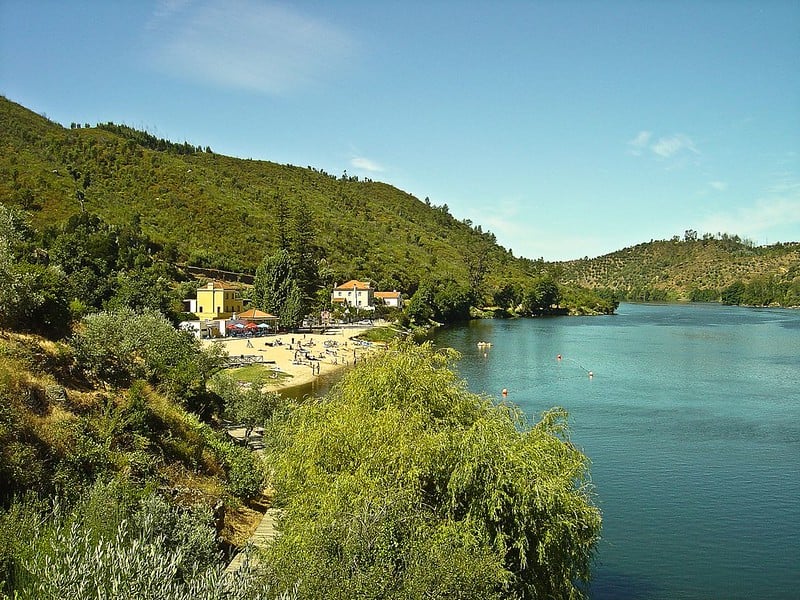
2. Praia Fluvial de Loriga (Serra da Estrela)
Often called the “beach of the glaciers,” Praia Fluvial de Loriga sits high in Portugal’s highest mountain range, Serra da Estrela. This remarkable river beach is formed by crystal-clear mountain waters flowing through granite rocks that have been sculpted by ancient glaciers.
Located near the picturesque mountain village of Loriga, this river beach is unique for its dramatic setting. Surrounded by terraced slopes and formed by the pure waters of the Ribeira de Loriga, the natural pools here are among the coldest in Portugal, which makes for a genuinely refreshing experience even on the hottest summer days. That’s right – the water is quite chilly! Don’t say we didn’t warn you!
Despite the chilly temps, the 800-meter Loriga River Beach is a must-visit for its beauty alone – even if your toes don’t even touch the water! Relax in several natural swimming pools and then grab a bite to eat at the bar. After swimming, don’t miss the opportunity to visit the historic village of Loriga itself, with its traditional stone houses and regional gastronomy specializing in like goat stew and mountain cheese.
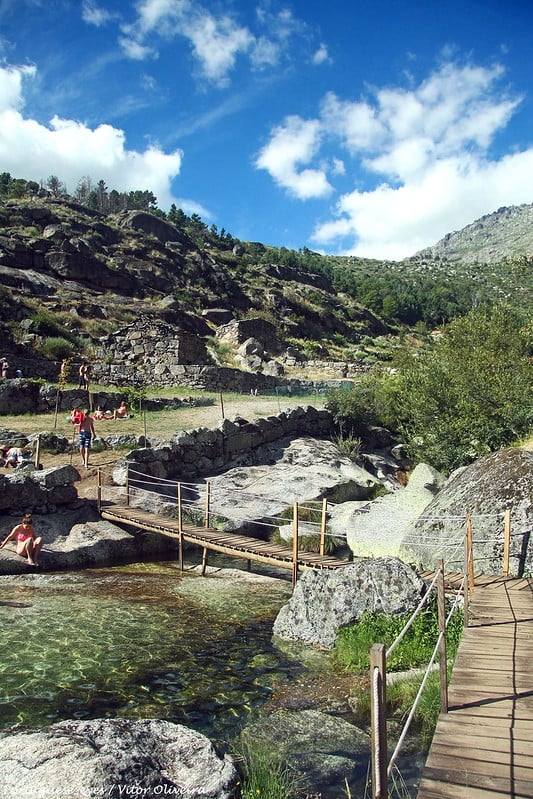
3. Praia Fluvial da Reconquinho (Penacova, Coimbra)
The Mondego River, Portugal’s longest entirely Portuguese river, hosts several excellent river beaches, with Reconquinho being among the finest. Located about 1.5 km Penacova in the central region, you can reach this expansive Blue Flag river beach by walking down a hill. Once there, you will be instantly charmed by its wide sandy shore and calm, clean waters.
The beach features excellent facilities including a restaurant, picnic area, a boat shelter, and lifeguards during the summer season. There is also a campsite near the beach.
Reconquinho is particularly popular with families due to its shallow entry points and supervised swimming areas. To get the full experience, stay overnight in the nearby town of Penacova, perched dramatically on a hillside overlooking the Mondego, and take in the beautiful scenery and pick up a traditional pastry called “pastéis de Lorvão.”
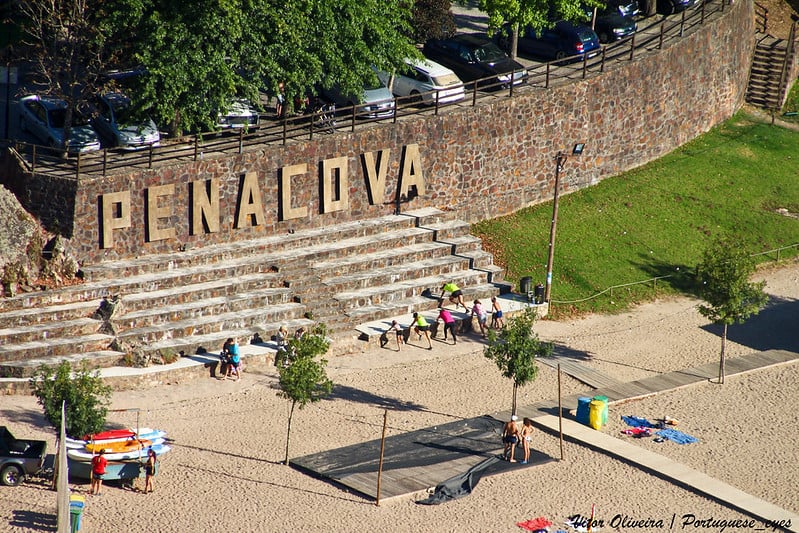
4. Praia Fluvial de Pego Fundo (Alcoutim, Algarve)
While the Algarve is famous for its coastal beaches, the inland river beach of Pego Fundo offers a completely different experience. Located near the border town of Alcoutim on the Guadiana River, this beach provides a relaxing alternative to the busy seaside resorts just an hour away.
What makes Pego Fundo special is its position on the Guadiana, with views across to Spain on the opposite bank. The beach has been thoughtfully developed with a spacious sandy area, shade structures, and a swimming area created by a small dam that ensures safe swimming conditions separated from the main river current.
The water here is notably warmer than many other river beaches, with temperatures that can reach up to 28 °C (82.4 °F) reflecting the hot climate of the eastern Algarve. During summer, the temperature difference between morning and evening is minimal, making this an ideal spot for evening swims after the heat of the day has passed.
The surrounding area offers beautiful hiking trails along the Guadiana, and the historic town of Alcoutim itself is worth exploring with its medieval castle and riverfront restaurants specializing in freshwater fish dishes. The international ferry that crosses between Alcoutim and Sanlúcar in Spain adds another layer of excitement to your visit.
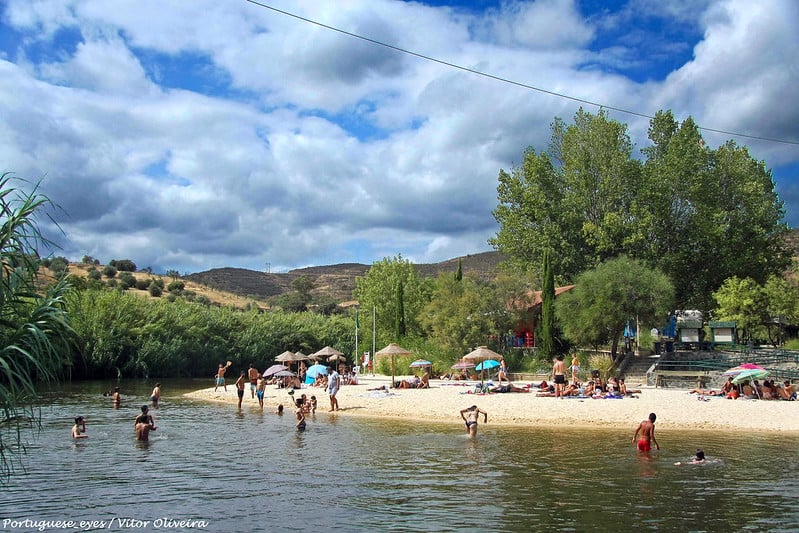
5. Praia Fluvial do Agroal (Ourém, Santarém)
Located in central Portugal, Praia Fluvial do Agroal stands out for the unique quality of its water. Fed by the Nabão River and natural springs, this river beach features mineral-rich waters that are believed to have therapeutic properties. So, if you visit this river beach, you are also getting a trip to a natural spa – a nice two for one.
The beach area has been thoughtfully developed with respect for the natural environment. There are both shallow and deeper sections to swim that are suitable for all ages.
What makes Agroal particularly special is the convergence of normal river water with the mineral spring water, which creates interesting temperature variations as you swim. The facilities here are excellent, with a drinking fountain, cafeteria, changing facilities, and a life guard on duty during the summer months. The historic city of Tomar is a short 20-minute drive away if you would like to see some Knights Templar history and also spend a day relaxing along this beautiful river.
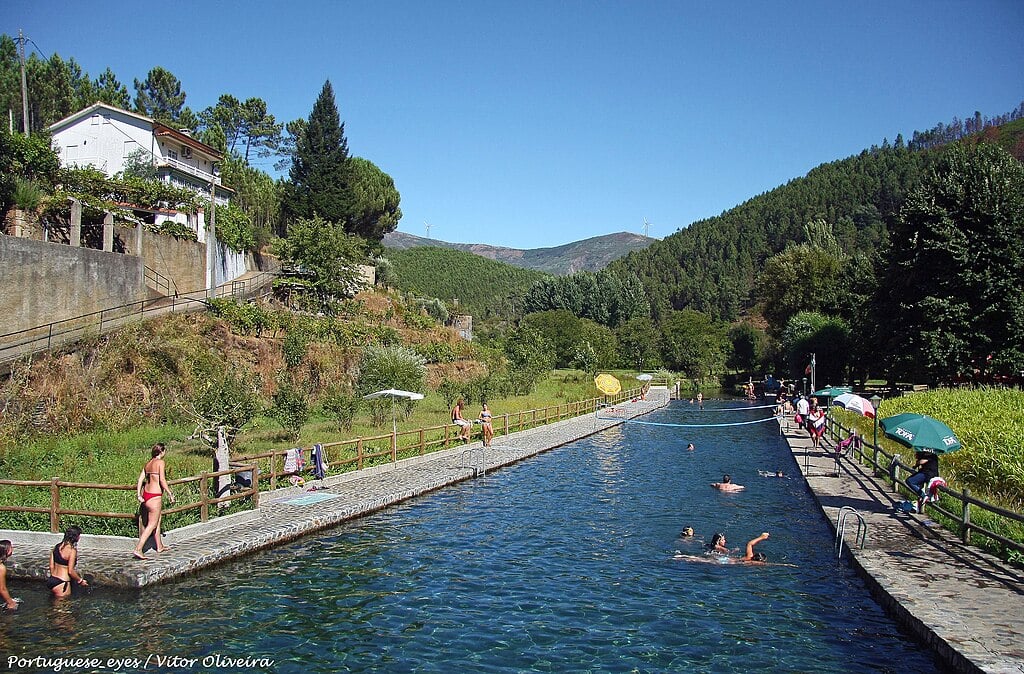
6. Praia Fluvial de Fragas de São Simão (Figueiró dos Vinhos, Leiria)
Perhaps one of central Portugal’s most photogenic river beaches, Fragas de São Simão is set within an amazing gorge where the rocky cliffs meet the crystal waters of the Ribeira de Alge. Located near Figueiró dos Vinhos in Leiria, a region devastated by wildfires in 2017, this beach is reached by a wooden walkway that is about 500 steps down, although parking is available closer to the bottom of the hill.
The towering rock formations that give the spot its name (“fragas” meaning rocky cliffs) create a cathedral-like atmosphere and provide shade during different parts of the day. We like that there is plenty of space to swim here and the wild setting of the beach makes you feel like you are in entirely different world altogether (although toilets are still available). Be sure to explore the surrounding waterfalls and mountain trails while you are in the area.
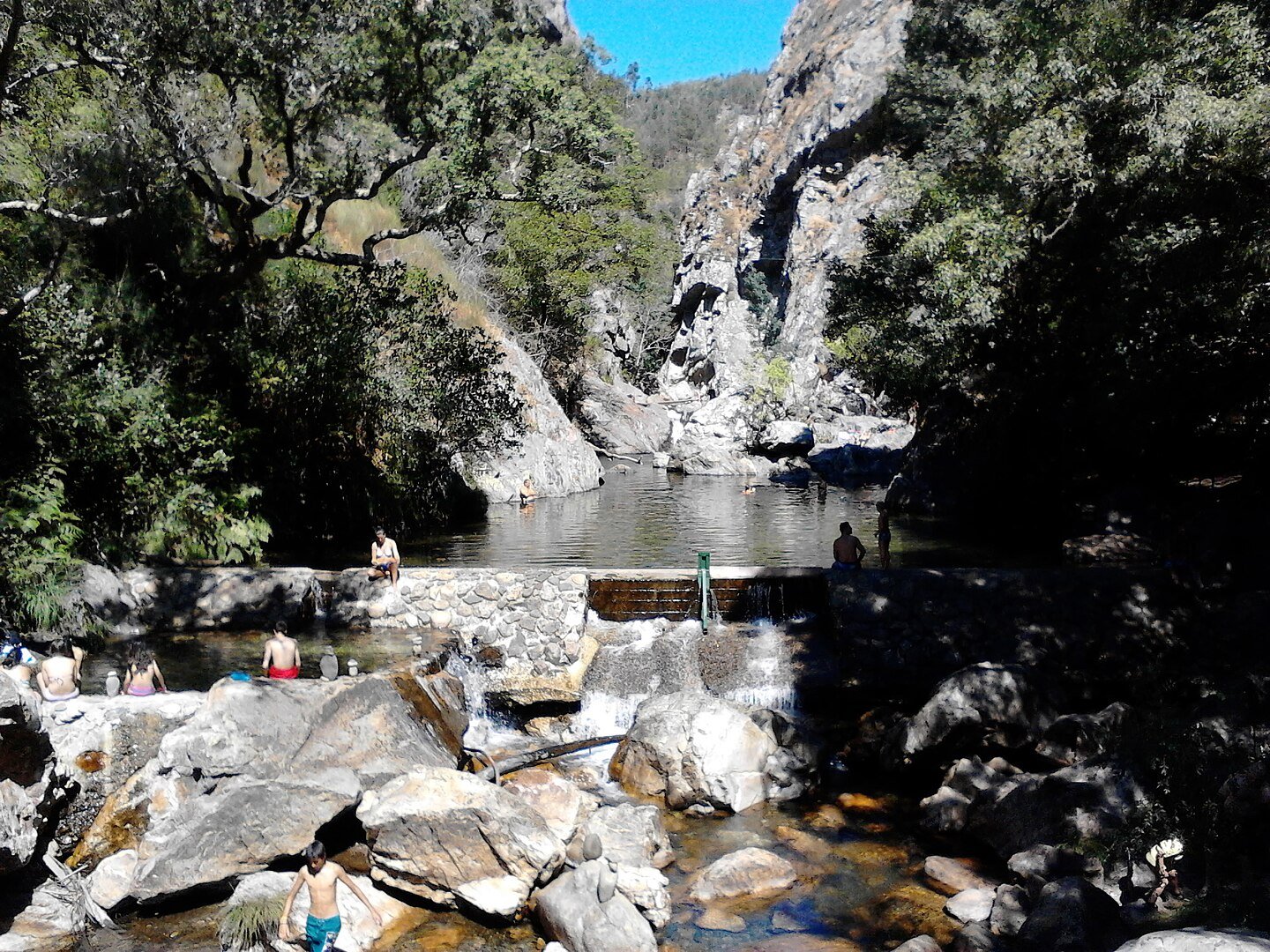
7. Praia Fluvial da Louçainha (Penela, Coimbra)
In the heart of Schist Village country, Praia Fluvial da Louçainha gives visitors the perfect example of historic rural Portugal. Located near Penela in the Coimbra district, this river beach on the Ribeira da Louçainha has been developed with special attention to integrating with the traditional architecture and materials of the region.
The beach features a large natural swimming pool created by a small dam surrounded by an expansive wooden boardwalk. You also have access to changing rooms, toilets with showers, a panoramic restaurant, and a picnic area. Life guards are also on duty during the summer months.
The water here is incredibly clear due to the water flowing through predominantly forested areas with little agricultural runoff. This is part of the reason why this beach has also been given a Blue Flag.
The nearby Schist Villages (Aldeias do Xisto) network offers opportunities to explore traditional mountain communities that have been revitalized through sustainable tourism initiatives. After a refreshing swim, visitors can explore these villages with their narrow streets and local craft shops.
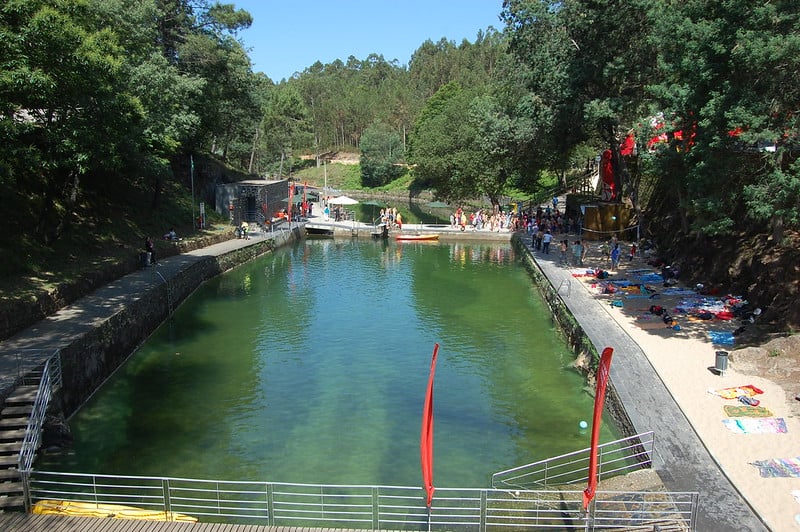
8. Praia Fluvial das Azenhas d’El Rei (Alandroal, Alentejo)
One of Portugal’s newest Blue Flag river beaches, Praia Fluvial das Azenhas d’El Rei is a perfect oasis on the shores of Europe’s largest artificial lake, the Alqueva reservoir. Located just 3 kilometers from the town of Montes Juntos in the municipality of Alandroal, this beach stretches for 148 meters and boasts impressive facilities that earned it both Blue Flag and Accessible Beach certifications. Wooden walkways provide easy access for visitors with reduced mobility, while the area includes a watchtower, lifeguard station, shaded areas, information panels, public bathrooms and showers. The adjacent leisure area features a restaurant with a terrace, boat ramp, anchorage for water sports, picnic areas, and ample parking.
One of the most unique aspects of this river beach is its location directly across from a Spanish beach in Cheles, Badajoz, which gives you an interesting mix of visitors from both countries.
If you’re looking for an authentic Alentejo experience, the beach serves as an excellent base for exploring the surrounding countryside with its small villages, rolling landscapes, and renowned local gastronomy, all while enjoying the perfect refreshing break from the intense summer heat.
9. Praia Fluvial da Albufeira do Azibo (Macedo de Cavaleiros, Bragança)
In the northeastern corner of Portugal, the Albufeira do Azibo reservoir hosts two exceptional river beaches: Praia da Ribeira and Praia da Fraga da Pegada. These twin beaches are situated within a protected landscape area in the district of Bragança, which gives visitors a unique lake-like experience far from the coast.
Both beaches have earned Blue Flag status for their exceptional water quality, safety standards, and environmental management. The backdrop of gently rolling hills covered in typical Trás-os-Montes vegetation creates a sense of peaceful seclusion despite the popularity of the twin beaches.
The calm, clear waters of the reservoir make this an ideal spot for families, with gentle entry points perfect for children and non-swimmers. Unlike many river beaches with rocky bottoms, the sandy shores here extend into the water, providing a more comfortable swimming experience. During the summer months, lifeguards are on duty, and floating platforms offer diving opportunities for the more adventurous among us.
Beyond swimming, the area offers numerous recreational activities including pedal boats, canoes, paddleboards, and hiking trails that circle the reservoir.
You can also find changing rooms, showers, picnic areas, and restaurants at both locations, which make these river beaches some of the most user-friendly in northern Portugal.
For travelers exploring the historic villages and natural parks of Trás-os-Montes, the Azibo beaches provide the perfect refreshing break.
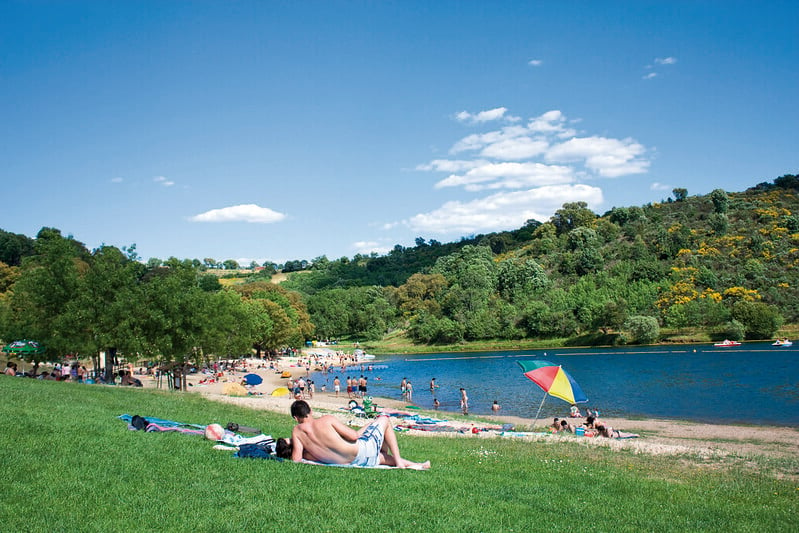
10. Praia Fluvial de Tapada Grande (Mina de São Domingos, Alentejo)
Perhaps one of Portugal’s most unusual river beaches, Praia Fluvial de Tapada Grande is located near the historic mining village of Mina de São Domingos in the eastern Alentejo and sits on an artificial lake created during the area’s mining heyday in the 19th century.
What makes Tapada Grande truly special is its desert-like surroundings. The reddish earth and sparse vegetation typical of this corner of the Alentejo create an almost otherworldly landscape that contrasts dramatically with the cool blue waters of the lake. The beach feels like a genuine oasis amid the scorching summer heat that characterizes this region.
Despite its industrial origins, the water quality here is excellent and has earned the beach Blue Flag certification. The lake is quite large, so you are guaranteed to have enough space to swim even during the busiest summer periods. A sandy beach area complete with free umbrellas, a restaurant/bar with a terrace overlooking the water, changing rooms, showers, and lifeguard supervision are all available during the summer. Visitors can also rent canoes to explore the lake’s perimeter or enjoy the various walking paths that connect the beach to the nearby village.
11. Praia Fluvial de Adaúfe (Braga, Minho)
In Portugal’s Minho region, Praia Fluvial de Adaúfe is a beloved summer destination just a few kilometers from the historic city of Braga. Set along the Cávado River, this beach features expansive grassy banks rather than sand, which gives visitors the chance to spread out under the shade of mature trees that line the riverbanks.
Facilities at Adaúfe include picnic areas with stone tables and barbecue pits – the perfect spot for a summer picnic. During the summer months, you can get a simple meal or some ice cream at a small café. The river is relatively shallow with a gentle current, which makes it safe for swimmers of all abilities, although we always recommend staying within the designated swimming areas.
What makes this beach stand out for us is its accessibility to the city of Braga. After visiting the city’s famous Bom Jesus do Monte sanctuary or historic cathedral, visitors can cool off at Adaúfe before sampling the region’s famous vinho verde (green wine) at nearby vineyards. Wine + culture + beach? What’s not to love?
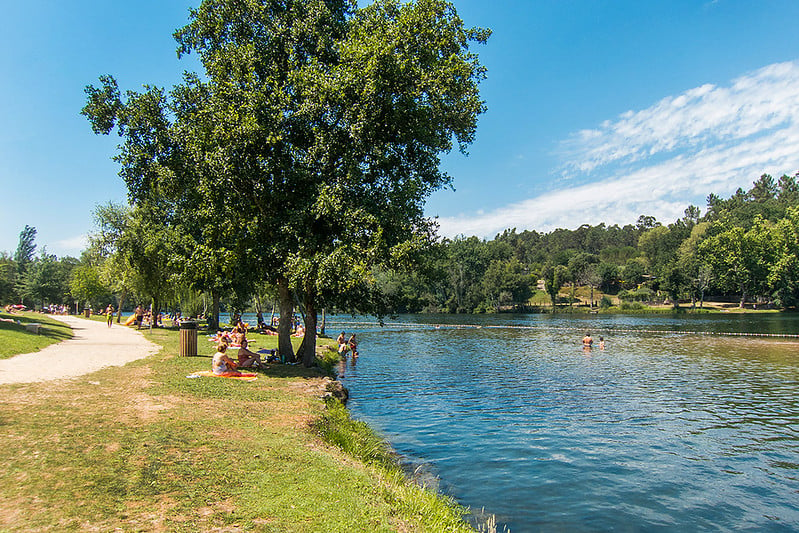
Final Thoughts
Portugal’s river beaches offer a perfect alternative to the often-crowded coastlines. Bathe in the heart of a glacial valley in Serra da Estrela, the warm southern waters of the Algarve, or the huge Alqueva reservoir in the Alentejo. Whichever river beach you choose, these praias fluviais are sure to provide a respite from the scorching summer heat.
These river beaches are still, in our opinion, some of the country’s best-kept secrets. Most, if not all of them, are only accessible by car with no public transportation options available. This is why they continue to remain off the beaten path for many.
However, as climate change brings increasingly hot summers to the Iberian Peninsula, these refreshing oases will become ever more valuable. Visiting respectfully, supporting the local economies, and preserving the natural qualities that make these places special will ensure that they continue to delight visitors for generations to come.
Which river beach in Portugal would like to visit first? Let us know in the comments!


